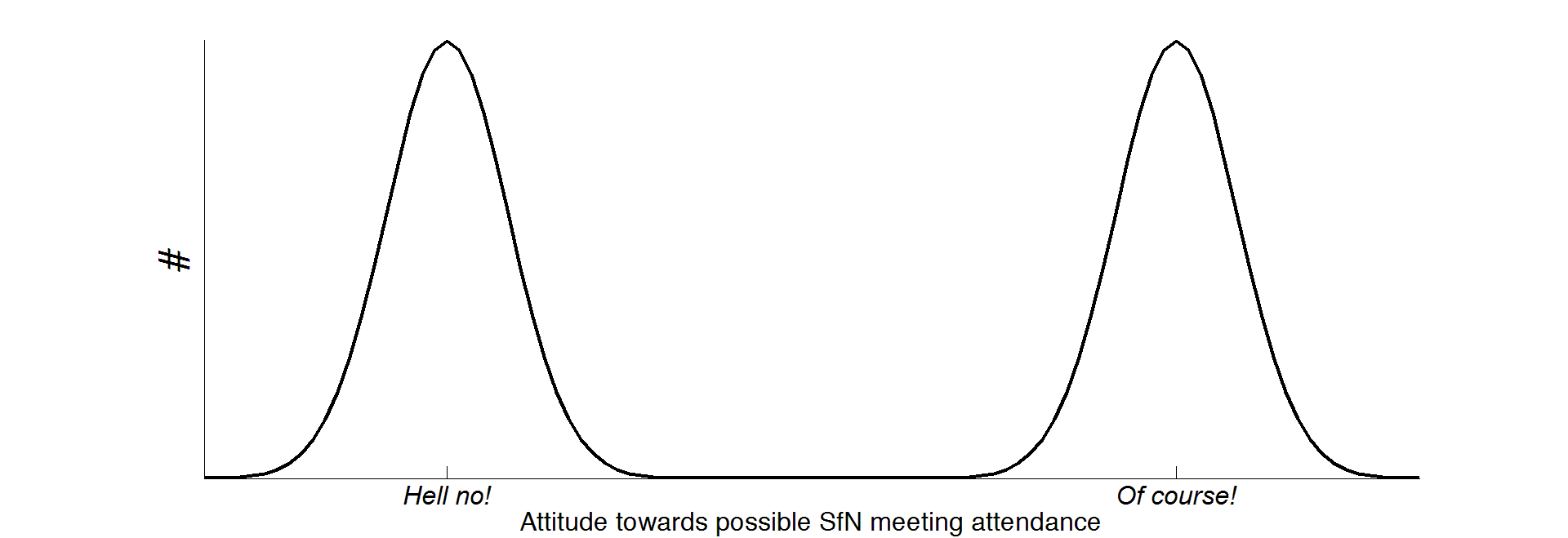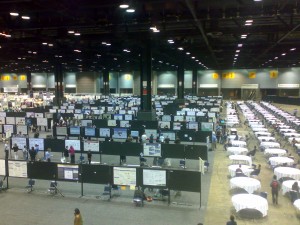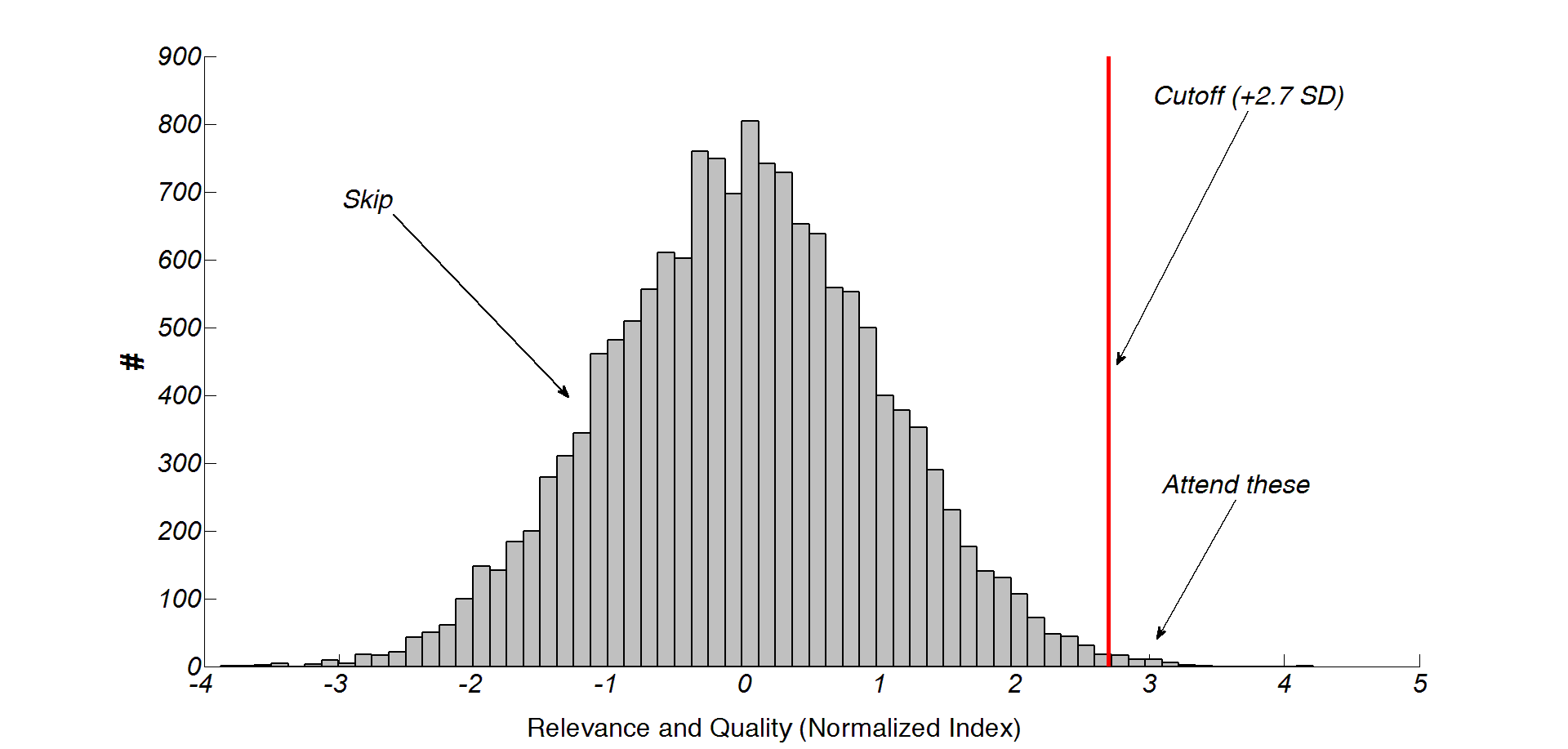In my experience, hardly are opinions toward any conference as polarized as those regarding the annual meeting of the Society for Neuroscience. When asking my colleagues about their feelings towards SfN and whether they are intending to attend this year, two quite distinct response patterns emerge. For some, it is their favorite meeting (“of course!”) whereas for others, it is their least favorite meeting (“hell no!”). Based on my informal sampling, we get an almost perfect bimodal distribution (and yes, I understand that the plural of anecdote is not data, but anecdata – yet it is the best I have (I am not aware of any literature on the topic)). If people from the group that doesn’t enjoy it are attending at all, they seem to consider it a necessary evil, because of the “exposure” at the meeting. 
Pressed on the question why they feel like that, the response is usually that it is overwhelming and that one doesn’t “get enough out of it” and that it is ultimately not worth the hassle.
This perception of “not getting enough out of it” is somewhat puzzling to me, as there really is an overabundance of opportunities at SfN. Personally, I place myself squarely in the camp of eager SfN pilgrims (I do consider it somewhat of an annual pilgrimage). As far as I’m concerned, the annual meeting is where it all happens. That’s where I gave my first “real” talk, that’s where I presented my first “real” poster, that’s where I effectively got both my current job as well as my first book deal – among many other things. The list is almost endless. I consider the SfN meeting as the gift that keeps on giving (as it repeats every year).
So why the disconnect between the groups? The first thing to keep in mind that SfN is radically different from pretty much all other Neuroscience conferences. Strategies developed to “do” other meetings will utterly fail at SfN. A simple and powerful heuristic at small meetings – to ensure that one is not missing something important or exciting – is to simply either attend ALL presentations, or go to all that sound even vaguely interesting or relevant. At a small meeting, one can easily do that. It doesn’t even require any preparation, so it is also convenient to do so. At SfN, one simply cannot do that. The sheer scope of the meeting does not allow it. Consider this quick and dirty calculation: Excluding special symposia, workshops, socials and lectures, SfN runs for a total of 9 sessions that last 4 hours each (Saturday PM to Wednesday PM). That is 36 hours of effective presentation time. Focusing on posters and talks (the “meat” of the meeting, there are also special lectures, symposia, etc.) this time is filled with 15345 posters (including theme H posters) and 1188 talks (called “nanosymposia” since the last meeting) for a total of 16533 poster and talk presentations this year. Talks last 15 minutes (12 presentation + 3 for Q&A), and I would say it is not unreasonable to budget 15 minutes to seriously visit a single poster as well (abstracting from the necessary transit time and waiting for the presenter to be available, this number might be not far from the actual time it takes to “visit” a poster). In other words, even if someone were to spend every available minute during that time at a presentation, the best they could expect to do is to attend 144 individual presentations (or less than 1% of the total). Now, who has 8 hours a day (day after day) of sustained attention for what are often highly sophisticated and highly technical points? The vigilance literature suggests that not many people do. Moreover, the literature on memory and learning suggests that one should expect massive interference (mostly retroactive, but also proactive) effects if one is sitting through one presentation after the other that is dealing with highly specialized, yet very similar materials. In other words, I don’t recommend even going to that many presentations. In my experience, *consciously* taking in about a third of that is reasonable. If you actually do learn (as in retaining them after the meeting) 50 new and important things at the meeting, I think it is time well spent. So that figure might represent an attainable and rational goal.
I understand that this seems to be a radical proposal… attending “only” 50 presentations corresponds to less than 1 in 325 of the total available at the meeting. While it can be incredibly exciting to see cutting edge science unfold or have a gifted presenter work his magic, it is important to keep in mind that there really is no such thing as a “must-see” presentation (as painful as that realization might be for the presenters, including myself). These are not classes. There is no test. There are no grades. As a friend of mine once put it (while skipping the morning session): If it really is important, it will be published later anyway (there is also an asymmetry – if it is actually published later, it only *might* be important). I am not sure what the empirical conversion rate between abstract and paper is (might depend on the field, I am not aware of any literature on this), I suspect it might be as low as 50% or less.
To summarize the points above:
a) Try to focus on a countable number (as in less than 10) of presentations per day. Don’t hesitate to spend an hour or more at a single poster if it is really something that is important to your work.
b) This almost necessarily implies that you will have to focus on individual presentations, NOT sessions. There is nothing wrong with attending several talks in a single session, but simply attending the entire session because it is more convenient to sit through it than to get up is not advisable (in order to conserve attentional resources).
c) No one keeps score of how many presentations you put under your belt. It doesn’t matter. What does matter is what you get out of the conference, and that quantity is only loosely correlated with the number of presentations you visit (attend?).
d) It is important to keep the “1 in 300” target in mind as a ballpark figure. This is actually very, very good news as it allows you to cherry-pick THE most relevant and THE most interesting presentations and focus on those exclusively. Luckily, SfN affords you with over 15,000 cherries to pick from. You can just sample from the extreme tail of the distribution and be well informed while at the same time saving yourself from premature exhaustion.
Of course, it is important to note that what is “relevant” is highly subjective and based on the individual (research) interests of the attendee. In other words, everyone has to carve out their own meeting. There is no “general list” of worthwhile presentations that one could compile and release. Another important point implied by this is that massive preparation is needed BEFORE the meeting. In my experience, it takes at least a full day to prepare for the meeting. But I was advised to keep my postings short, so it will be the topic of a future post how exactly to do this preparation.
In any case, I routinely see colleagues with a schedule that lists several hundred individual presentations. While ambitious, the calculations above suggest that attending that many presentations (however tempting this might be) is not physically possible (due to constraints of space and time), to say nothing of cognitive constraints. I see them attending a several full sessions of talks (in a given AM (8 to 12) or PM (1 to 5) time slot), then dart off to the posters in the hour that remains before the end of the slot, frantically jumping from one poster to the next in a “too little too late” last ditch effort to see as much of the things on their list as possible (spending about one minute per poster). This is pure futility.
It is thus not surprising that those who apply a comprehensive “small-conference” strategy to a conference like the SfN meeting will meet with disaster. They will predictably be overwhelmed and exhausted, while retaining very little of value.
Now, the point here is not to mock anybody. As a matter of fact, I have myself executed exactly this doomed strategy at more than one SfN meeting. But that approach failed decisively… every single time. I will end my post at this point and relegate details on how exactly it failed to a future posting.



Pingback: Tweets that mention How I learned to stop being overwhelmed and love the meeting – or: How to do SfN, part I | Pascal's Pensées -- Topsy.com
Pingback: How I learned to stop being overwhelmed and love the meeting – or: How (not) to do SfN, part II | Pascal's Pensées
Pingback: SfN 2010: The 100-hour dash | Pascal's Pensées
Hola,
Todo dinбmica y muy positiva! 🙂
Kicker